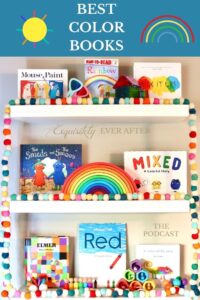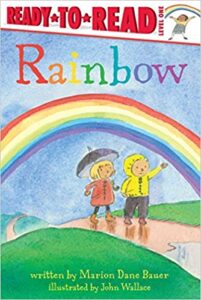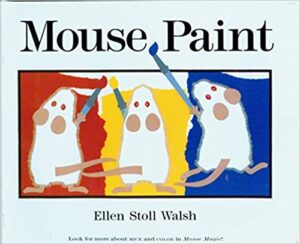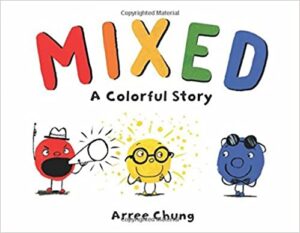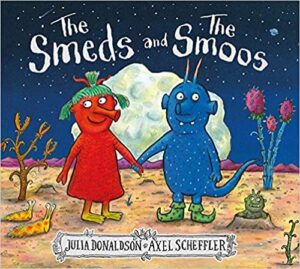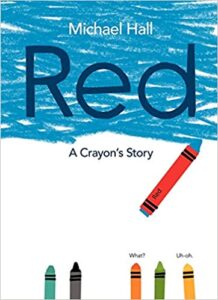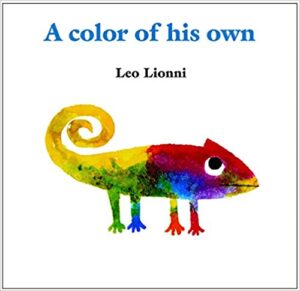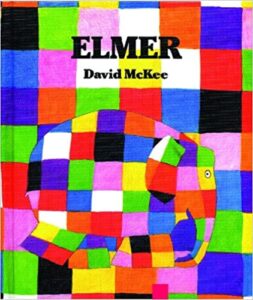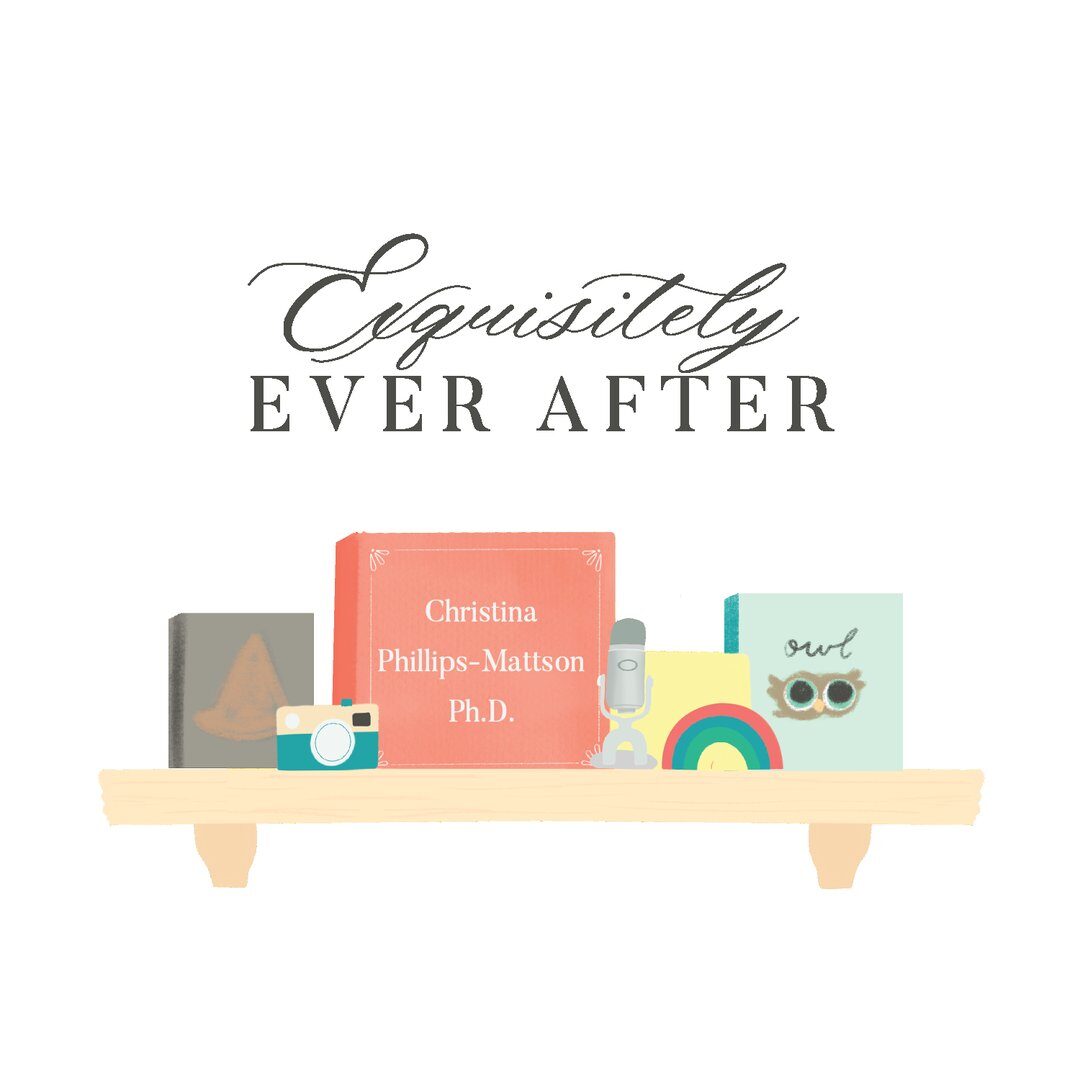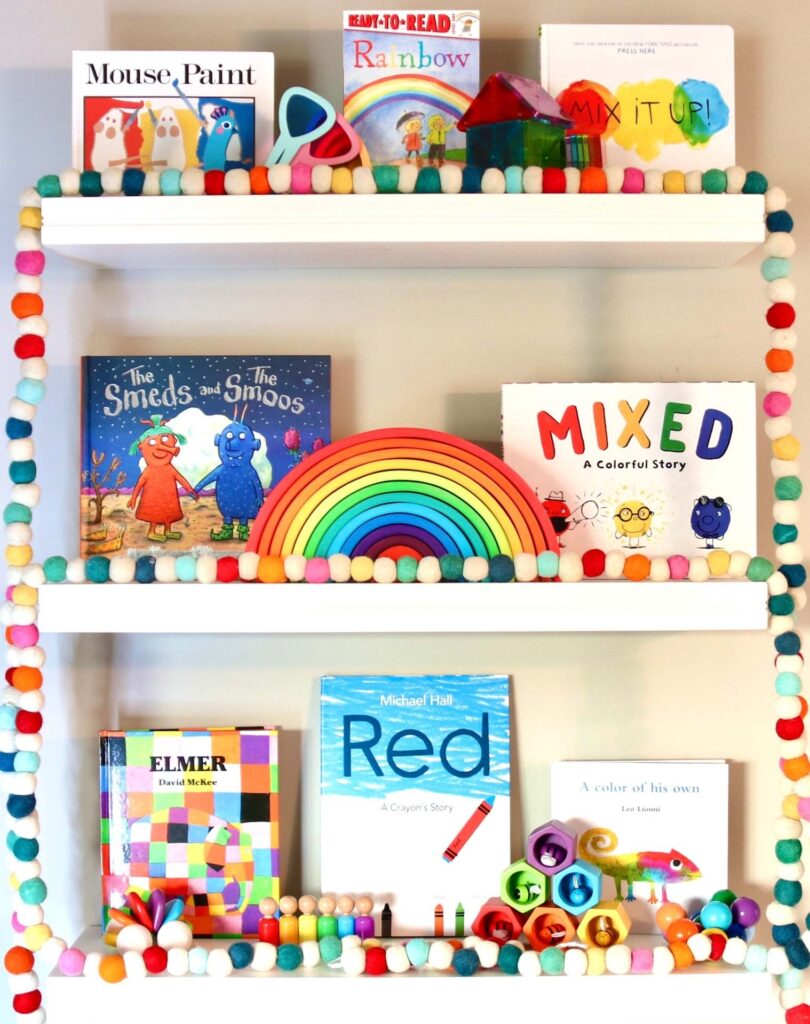
Some links are affiliate links. Please see more here.
SUMMARY: In Part 2 of our color series we’re going to discuss books that will help you teach your Preschoolers, Pre-Kindergarteners, and Kindergarteners about the color spectrum and basic color theory, including the concept of primary colors, secondary colors, and mixing colors. Additionally, I recommend picture books that use the concept of color to help your child embrace his or her individuality and promote tolerance and acceptance. Included in this episode are also ideas for hands-on supplemental color activities for you to do with your child that will help you solidify these concepts in your child’s mind and provide you both with some fun ways to pass the time if you are social-distancing as much as possible this year.
Listen to the Podcast Episode:
Books Mentioned in this Episode:
*Rainbow by Marion Dane Bauer, illustrated by John Wallace
A Rainbow of My Own by Don Freeman
How the Crayons Saved the Rainbow by Monica Sweeney, illustrated by Feronia Parker Thomas
*Mouse Paint by Ellen Stoll Walsh
Mouse Count by Ellen Stoll Walsh
Mouse Shapes by Ellen Stoll Walsh
*Mix it Up! by Hervé Tullet
Press Here by Hervé Tullet
*Mixed: A Colorful Story by Arree Chung
*The Smeds and The Smoos by Julia Donaldson, illustrated by Axel Scheffler
Room on the Broom by Julia Donaldson, illustrated by Axel Scheffler
Romeo and Juliet by William Shakespeare
The Tempest by William Shakespeare
A Midsummer Night’s Dream by William Shakespeare
Alice’s Adventures in Wonderland by Lewis Carroll
A Book of Nonsense by Edward Lear
How to Be An Antiracist by Ibram X. Kendi
Children’s Literature Grows Up: Harry Potter and The Children’s Literature Revolution by Christina Phillips-Mattson
*Red: A Crayon’s Story by Michael Hall
*A Color of His Own by Leo Lionni
*Elmer by David McKee
Note: Books marked with * are the focus books of this episode.
Activities/Crafts Mentioned In This Episode:
Tissue Paper Rainbow Suncatcher
Rainbow Handprints and Footprints
Dyed Pasta 3D Rainbow Art
Finger Paint Color Mixing
“You Have The Magic Touch!” Page (Re)Creation
Coffee Filter Color Mixing Activity
Hide the Chameleon Activity
Elmer’s Day Parade Elephant Craft
Toys and Activities Mentioned in this Episode:
Learning Resources Primary Science Color Paddles
Podcast Transcript:
Hello Everyone! Welcome to Part 2 of our little mini-series on color books. Last week, in Part 1, we talked about books, activities, and toys that will help your children learn to identify and label colors, and this week we’re going to discuss books that will help you teach your older preschool, pre-K, and kindergarteners about the color spectrum and basic color theory, like the concept of primary colors, secondary colors, and mixing colors. Additionally, I’m going to recommend some picture books that use the concept of color to help your child embrace his or her individuality and promote tolerance and acceptance. So if you missed last week’s episode and you want to work on identifying and labeling colors with your child, I recommend that you pause this episode and go back and listen to Episode 12. As in last week’s episode, I’m also going to give you a few ideas for some hands-on supplemental color activities for you to do with your child that will help you solidify these concepts in your child’s mind and hopefully provide you both with some fun ways to pass the time if you are social-distancing as much as possible this year. And along with the activities, I’m also going to recommend a few toys that I think are helpful for teaching your child these concepts.
Okay, so let’s start with a concept book that will help teach your child about rainbows and the color spectrum. It’s called Rainbow by Marion Dane Bauer and illustrated by John Wallace and it’s part of a series of nonfiction books they call Ready-to-Reads that they’ve written on things like snow, wind, volcanoes, the sun, and so on. I like this book for a bunch of reasons. First, I like that it’s full of interesting facts about rainbows that will help satisfy inquiring little minds. For example, it talks about how rainbows are formed when sunlight bounces and bends to separate into different colors as it passes through raindrops; it talks about upside down rainbows which are called sun smiles; and it also addresses the whole pot of gold at the end of a rainbow thing and explains that this can’t be true because rainbows are actually round. However, I also like that even though it gives your child a science-based explanation for what rainbows are and how they’re created, this book doesn’t squash how magical rainbows are for little kids. It still focuses on the wonder and excitement spotting a rainbow inspires at this age.
The pencil and watercolor illustrations are also really cute and I like that many of the children and adults depicted are of different races and ethnicities. And finally, I also like the engaging way that this book is written. Even though it’s a concept book whose whole purpose is to teach a child about rainbows and the color spectrum, it isn’t just a boring list of facts. Instead, it engages the child by asking her questions and encouraging her to use her own powers of observation, like when the narrator asks: “Have you ever seen a surprise in the sky on a rainy day?” or when it tells the child exactly what to do to see a rainbow next time the sun comes out while it is still raining by explaining how you must stand with your back to the sun. It’s a really informative, interesting book for 3 to 5- year-olds and another bonus for this age group is that it’s a great early reader book because it’s full of easy sight words and words that are easy to sound out.
Now, just FYI if your child is really into rainbows, there are a couple of other cute fictional books about rainbows that you can read with him, like Don Freeman’s classic, A Rainbow of My Own, and How the Crayons Saved the Rainbow by Monica Sweeney and illustrated by Feronia Parker Thomas. Neither of these is very informative as far as how rainbows are made or, in the case of Freeman’s book, very accurate in what a rainbow looks like, but if your child is a rainbow fanatic, these two books could be fun supplemental read-alouds for your family.
Additionally, there are a bunch of fun rainbow activities that you can do with your child. There are literally hundreds on Pinterest, and there are so many great ones, but honestly, one of our favorites was actually just creating rainbows at home using a clear glass, water, and a large piece of white paper. You just put the piece of paper down flat in the sunlight, fill your glass a little over half full, and then hover the glass over the paper and tilt it in the beam of sunlight until you see a rainbow. It’s super simple, but really fascinating for children. Then you can explain to your child, using the Rainbow book, where the rainbow came from. Using the book, you can talk about how all of the colors of a rainbow are always in sunlight, but we just can’t see them because they’re all mixed together. But, when sunlight moves from the air into the water in the glass it bends in a special way called “refraction.” When it bends, the light separates into all of the colors of the rainbow. So then you can explain to your child that we see rainbows outside when there is a lot of sunlight and a lot of water in the air. And then you can say, “The water in the air acts just like the water in the glass; the light refracts as it moves from the air into each water droplet.” In this way, it makes it easy for your child to make the connection that the big rainbows that we see outside come from all of the light being refracted through lots of separate drops of water all at once.
Ini my family, we also really enjoyed doing a few rainbow crafts to supplement our learning about rainbows. Again, there are a ton of rainbow crafts that you can find on Pinterest, but here are three that my preschooler and I really liked and that were very easy to do:
Tissue Paper Rainbow Suncatcher
The first craft was making a tissue paper rainbow suncatcher. This is a super easy craft to do with your kids who are 3 and up. You’ll need contact paper or laminating sheets (which is what we used), tissue paper in rainbow colors, scissors, and if you want to follow a rainbow template to make the rainbow arc more precise, you can use one of those, too. I made one myself and I turned it into a free PDF, so if you’d like to use it, I’ll link it in the shownotes. And then, at the end, I also used cardstock to make a little frame around the rainbow, but that is definitely optional, too.
Okay, so what you do is: you or your child, depending on your child’s age and scissor ability, cut each color of tissue paper into little tiny squares. Then, if you’re using a template, you put the template underneath one sheet of contact paper, making sure the sticky side is facing up (you don’t want the sticky side to touch your template). Next, have your child place the tissue paper squares in rainbow color order on the sticky paper (this is where the template comes in handy because it acts as a guide for the rainbow shape AND your child can match the colors with the template). Then, once the rainbow is complete, you can either cut strips of cardstock and place them on the sticky paper to make a frame around your rainbow, or, if you just like it the way it is, all you have to do to finish it is simply place another laminating sheet or piece of contact paper cut to the same size as the original sheet, on top of your rainbow. And you’re done! You can then tape it to a window or use a hole punch and a piece of string to hang it in a sunny place. My preschooler loved this craft and we actually made a couple of these rainbows to give to family members. Oh! And just one last tip: When we put the second piece of laminating paper on the rainbow, I used a dough scraper to try to smooth out any large air bubbles, but you can use a butter knife or the edge of a book or whatever else you have on hand.
Rainbow Handprints and Footprints
The second rainbow craft that we did was paint our hands and feet the colors of the rainbow and then make rainbow handprint artwork. A word of warning—this activity can make a really beautiful gift for someone or keepsake for you to have your child’s handprints and footprints BUT it is very messy and by the end of the activity, we were all covered in paint. So, if you are doing this with more than one child, it probably works best if there are two adults present (one to help paint the child’s hands and feet and one to help them get their hands and feet onto the paper). But both of my kids thought it was so fun having their hands and feet painted and we all loved the result, I’ll put a picture of the hand and footprints in the shownotes. It was definitely worth it, but, again, you know, to paraphrase the words of the Gringotts goblins, “Parent, you have been warned, beware, of finding more than treasure there.”
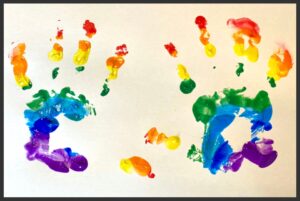
Dyed Pasta Rainbow 3D Art
Okay, the last craft we did was a sort of sequel to an activity I talked about last week in Episode 12. We used the pasta that we dyed rainbow colors and, using the same template that I made for the tissue paper rainbow suncatcher craft, my toddler and my preschooler made a rainbow and cloud scene using the colored pasta, cotton balls, and glue. My preschooler separated the pasta by color and, using the template as a guideline, he pasted the pasta to a piece of cardstock in rainbow color order and then glued little cotton balls to the ends for clouds. You can also make this even more of a sensory experience if you want to add glitter or sequins for raindrops or make a sun and sunbeams out of yellow puffballs and yarn. Really, whatever your child wants to create is great. And if you want to learn how to dye the pasta, just head to the shownotes of last week’s episode at www.exquisitelyeverafter.com/episode12 and you’ll see all the instructions for that craft. And if you’d like the rainbow template for this craft, it will be in the shownotes of this episode at exquisitelyeverafter.com/episode13.
And finally, before we move on from rainbows, a great toy that my kids love that helped them learn the colors of the rainbow and their order is a wooden rainbow stacking toy. There are a ton of these out there, but I’ll link a couple that we like and have found to be durable in the shownotes.
Okay, so now, let’s move on to books that will help teach your child about primary and secondary colors and color mixing.
The first is a classic by Ellen Stoll Walsh called Mouse Paint. What I like about this book is that, even though it’s a concept book whose goal is to teach a child about primary and secondary colors and how to make secondary colors out of primary colors, it accomplishes this through a story rather than just straight up telling the child that red and yellow make orange, blue and red make purple, and blue and yellow make green. Instead, Ellen Stoll Walsh tells a little story about three white mice who are able to hide from a cat on a blank piece of paper. One day while the cat is asleep, the mice see three jars of paint: one red, one yellow, and one blue. The mice think the paint is mouse paint so they each climb in a jar and come out a different color. Then they see what happens when they jump and dance in the puddles of paint they’ve created and learn that, for example, red mouse feet dancing in a yellow puddle make orange. The mice experiment making secondary colors from the primary colors and then end the story by washing the paint off themselves and painting the paper instead… but leaving a little bit of white, because of the cat.
I love this simple, charming story because it definitely makes learning the concepts of primary and secondary colors and color mixing more engaging for the child reader in addition to making it more memorable. I like that the author doesn’t stop with the mice washing off the paint, but that she continues the lesson by having them paint the paper and mix each set of colors again. This really reiterates how each secondary color is made through primary color mixing and helps your child commit it to memory. It’s really well done and if your child likes this book and responds to this style of concept-teaching, Ellen Stoll Walsh also has a couple of other companion books like Mouse Count and Mouse Shapes that teach other important concepts to this preschool/kindergarten age group.
The second book that I think is really excellent for learning about color mixing and primary and secondary colors is Hervé Tullet’s fantastic interactive book called Mix It Up! This book is a companion book to Tullet’s New York Times bestseller Press Here and I have to say, I might like Mix It Up! even more than that one. What Tullet does is give direct instructions to the child reader/child listener to interact with the daubs of paint he has splodged on the page. With each turn of the page, a new direction is given, like, for example, he says: “Try taking some of that yellow… and smudging it on the red.” And then the next page shows the resulting orange splotch, with the red and yellow still peeking through. Tullet asks the child to smudge, rub, tilt, shake, smoosh, and push the colors and the book so that the book itself becomes an interactive experience that relies on the child’s action, participation, and imagination. It’s awesome.
There are so many things that I love about this book. First, I love how incredibly participatory this book is without having any flaps or pop-ups or any other gimmick. It relies completely on the reader’s imagination, which is so empowering for the child and so great for her brain. The questions Tullet asks and the directions he gives require real critical thinking and problem-solving and will help your child develop her memory and confidence as well as her fine and gross motor skills. She’ll also learn about cause and effect and, of course, the main thing for our purposes today, she’ll learn about primary and secondary colors and color mixing!
And another thing I love about this book is that Tullet doesn’t stop with just mixing red, yellow, and blue to make green, orange, and purple, but he also shows how different shades are created, for example, how white makes colors lighter while black makes them darker. And especially interesting for my preschooler was how different actions produce different results, like smushing a black blob and a white blob together by closing the book creates a different result than shaking the book when we mixed yellow and blue paint.
Finally, as a parent, I also love that this book engages my child and lets him “paint” without actually making a huge mess. Don’t get me wrong—I love doing painting activities with my kids because I know how much they enjoy it and how good it is for their little brains and imaginations, and, I mean, I also love to paint and mix colors and create things myself… HOWEVER, there are certain times and certain days that you just don’t have the time or the energy or the space or the materials on hand to make a huge marvelous mess (like, for example, at 8 p.m. on a school night or when you’re all dressed up to attend your cousin’s wedding). At these times, this book is such a terrific substitute because your child really feels like she is having an imaginative, hands-on experience.
Okay, as far as supplemental activities and toys that can help your child explore color mixing and the concepts of primary and secondary colors, first and most obviously, painting or finger painting is always so much fun for kids and a great, hands-on way for them to learn about color mixing. Just set out red, blue, and yellow paint and maybe some black and white paint and give them some paper and let them start mixing. Or, you could also recreate some of the art in the Mix It Up! book by giving your child the same directions and then comparing the results to the art in the book.
“You Have The Magic Touch!” Page (Re)Creation
Also, the “You have the magic touch!” page in Tullet’s Mix It Up! where the outline of the child’s hand is left on the paper surrounded by multicolored dots inspired a really fun and personal keepsake gift idea. This page is actually really simple to recreate. All you have to do is trace your child’s hand on a piece of construction paper and cut it out. Make a couple of little loops of painter’s tape and put them on the back of the cut out hand to secure your child’s hand print on a blank piece of white paper (we used cardstock so that it wouldn’t tear as easily). Then, using finger paint, have your child mix a bunch of colors to dot finger prints all over the page. Your child could do finger prints all in shades of one color, or in her favorite colors, or make a pattern with multiple colors—the possibilities are really endless. Then, once the paint dries, simply peel off the handprint and you’ll have a really cool piece of art you can frame as a keepsake or give as a gift.
And, if you want to do another activity that doesn’t involve paint, one that we liked was a color mixing science experiment that uses markers. All you need is a coffee filter; red, blue, and yellow washable markers; a cup of water; and an eye dropper. The only prep you as the parent need to do is fill the cup with water and then, depending on your child’s age, help her draw three lines on the coffee filter separating it into thirds. Then, you have your child color in each third with one primary color so in the end you have a red, a blue, and a yellow section. Next, have your child fill the eye-dropper with water and slowly drip water onto the colored coffee filter. The key here is to go very slowly and only drip a little bit of water at a time. Pretty much immediately, the colors will start to mix and blend together to make green, purple, and orange patches on the filter. We colored a bunch of filters and instead of separating them all into thirds, we experimented with making different patterns to see how different each filter would look when they dried. And when they do dry, they’re actually very pretty so we turned ours into a pretend flower bouquet by folding the filters up like accordions and twisting a pipe-cleaners around the centers to make the stems.
Finally, if you’re looking for toys that can help you supplement your child’s reading and learning about color theory, my four-year-old is absolutely obsessed with Magna Tiles, which, if you’re not familiar with them, are magnetic building tiles that kids can use to create all sorts of colorful structures. They are a terrific STEM toy for developing spatial and tactile skills as kids sort and click together the tiles to create new buildings and structures and designs. But what is also fun is to hold them up to the light or use them with a light table to see what new colors can be created when the tiles are stacked on top of each other. We have an excellent, durable light board that takes up less space than an actual light table that I’ll link it in the shownotes in case you’re interested. My son James will literally spend hours building and rebuilding with these things, so they are definitely worth the investment. Plus, even though they are technically for 3 years and up, my 20-month-old, Luke, loves stacking the tiles and helping my four-year-old with whatever he’s building, so it’s one of those activities that my kids can play together despite their age difference.
Another toy that they both really enjoy, although it’s targeted for toddlers, is a wooden peacock with colored lenses for tailfeathers. Your child can hold the tailfeather up to her eye and look through the colored lens and whatever she sees will be tinted in that color. But what’s cool about it for today’s purposes is that your child can hold two lenses up together and see how the colors mix to make a new color AND, because this peacock has lenses in pink and pale blue and light green, your child can see how tertiary colors are formed. Like, for example, that pink and light blue make a violet color or that light blue and light green make a teal color. We have other lenses that are similar to this peacock made by Learning Resources and even though they aren’t as cute as the peacock, there are more colors to mix. So I’ll link both in the shownotes in case you’d like to compare them.
Now that we’ve talked about books that can help you teach your child basic color theory, there are a few other really excellent books about colors that I’d like to recommend if you’d like to continue this color-themed reading with your child or, if you are doing school at home this year and you’d like to do a little color unit and you need some ideas for more books that highlight this topic. I love that in these picture books that I’m going to discuss, the writers and illustrators have employed the concept of color to help the child learn about other ideas, like inclusiveness and individuality. It’s such a creative, engaging way to bring up these topics for this early years age group without being too didactic or getting too preachy.
So, first up is Mixed: A Colorful Story, written and illustrated by Arree Chung. I love this book because it’s partly an origin story for non-primary colors, partly an exploration of the causes and effects of racial prejudice, and partly a celebration of diversity. This sounds like a lot for one picture book, but it’s actually really straightforward, funny, engaging, and very visually appealing. Basically, the story goes like this:
In the beginning, there were three colors: reds, blues, and yellows, all anthropomorphized as little dot creatures, each group uniquely special in its own way, and all living together in harmony. But then one day, one of the colors announces that it is the best color and a disagreement breaks out that spreads to all three of the color groups in the city. In their anger, reds, blues, and yellows segregate themselves to different parts of the city, building barriers to keep the other colors out. But then one day, a Blue meets a Yellow and they find that they not only like each other’s differences, but that their differences complement each other and make them each better than before. Much to the disapproval of the other colors, this special pair decides to mix by joining together in a marriage ceremony and they create a new color: an adorable baby green dot named Green who is a mix of her parents’ traits and yet a color all her own. The other colors are so enamored by this adorable new hue that they begin to rethink their ideas and values. Soon more colors begin to mix and even more non-primary colors are created as the new generations of secondary and tertiary colors mix and mix and mix. Finally, realizing that the old separated neighborhoods don’t reflect the beauty of their colorful world, the little color dots tear down the barriers and rebuild their city to reflect their diversity.
So, first of all, for our purposes today, I really love that this book is like an origin story for colors. It’s such a fun, clever way to teach kids about primary and secondary colors and tertiary colors and color mixing. I love the whole idea of making colors into little clans and, visually, the little anthropomorphized dots are so cute. And in general, I’m a big fan of the way Arree Chung decided to illustrate this story, making everything else black and white and minimal so that the colors really stand out on the page. It’s very striking and definitely grabs the reader’s attention.
Second, I love the gentle, age-appropriate way this book comes at the really difficult subject of racial prejudice. I know I’ve said it before, but it is so crucial that we talk to our young kids about racism and help them become accomplices in the fight for equity and justice for everyone right from the very beginning. But it can be really hard for parents and caregivers to know how to begin to talk about these things and so this book can help grown-ups initiate conversations about diversity, tolerance, and acceptance with even very young children because these concepts are presented in such an accessible way. By using the anthropomorphized colors, Arree Chung makes it easy for little kids to grasp why, for example, the idea of a superior race is harmful (and, also, you know, completely ridiculous), because they get why it’s wrong and absurd for the reds to announce that they are better than the blues and the yellows. And, in the same way, children also can understand why segregation is destructive and damaging because they see why it’s harmful for the city when the colors separate themselves and shut themselves off from each other. And, on a positive note, through this book, children can also appreciate why diversity makes the world a more interesting, beautiful, and joyful place because, at the end of the story, they see how it’s so much better for the city and for all the colors when there are lots of different colors living and working together. Books like this one and the next book I’m going to talk about make it easy for kids to make connections between the fictional world and the real world, so they help children expand their empathy, which, of course, is the most important quality to cultivate when you’re trying to raise kind humans.
Next up is a book that, like Aree Chung’s Mixed, uses color difference to promote tolerance. It’s called The Smeds and The Smoos by Julia Donaldson and illustrated by Axel Scheffler. As I’ve mentioned before, Julia Donaldson and Axel Scheffler are one of my absolute favorite author/illustrator teams. They’ve collaborated on a great many books together—almost too many to count—and I love them all but I have to say, this book is in my top 5 of their collaborations. It is so fun and so outlandishly creative, but underlying all of its whimsy and humor is a very profound message of acceptance of people who don’t necessarily look or act like you. It’s written entirely in verse and, as I said, it’s humorous and poignant all at the same time, AND it is at once a modern picture book and an old-school classic picture book which, I think, is Julia Donaldson’s particular brand of literary genius. Everything she writes feels incredibly fresh and new, but also cozily familiar and timeless. I talked a little bit more about this in Episode 11 when we were examining Room on the Broom so if you haven’t heard that one yet and you want to learn more about Julia Donaldson and the cauldron of story, you can go back and have a listen to Episode 11.
So, here’s the plot of The Smeds and The Smoos: On a far-off planet there live two alien/extraterrestrial children, Janet and Bill, who belong to two different clans: The Smeds and The Smoos. The Smeds are red, have hair, love the water, drink pink milk, and sleep in beds; The Smoos are blue, have horns, wear shoes, love to jump around, and sleep in holes in the hillside. The clans are taught from a young age never to mix or interact with each other, each clan citing the other clan’s differences as points of contention and/or things to be disparaged. As children, Bill and Janet happen to meet one day in the forest and strike up a friendship. When they are discovered by their respective grandparents, the two children are berated and forbidden to see each other. They continue to meet, however, throughout their childhood and adolescence, and, finally, when they are adults, decide to marry. The two clans, led by the grandparents, are outraged, so Bill and Janet steal Grandfather Smed’s rocketship and sneak off to elope together. When the remaining Smeds and Smoos discover that Bill and Janet are missing, they all grudgingly form a search party and travel from planet to planet on Grandmother Smoo’s rocketship in search of Bill and Janet. They travel to all sorts of different planets with all sorts of diverse inhabitants, and, along the way, they begin to grow accustomed to and even fond of each other. When they finally give up and return to their planet, the Smeds and the Smoos have, in spite of themselves, become friends and, really, one big family, a fact which is further solidified when they discover that, in the year that they’ve been gone, Bill and Janet returned and had a baby, a tiny purple Smoo-Smed whom they all adore. The book ends with a huge celebration and the words:
Play with the Smeds and play with the Smoos.
Play with whichever friends you choose.
Then close your eyes and while you snooze,
Dream of the Smeds and dream of the Smoos.
Okay, there is so much that I love about this book. First of all, the illustrations are so, so great. I think this intergalactic setting must have been very fun for Axel Scheffler to illustrate and it really plays to his strengths of creating witty, vibrant, fantastical scenes and creatures. He does an excellent job of bringing Donaldson’s descriptions of the Smeds and the Smoos to life and making them both alien and familiar at the same time. Oh! And also, if your kids are fans of the Julia Donaldson and Axel Scheffler books, you’ll know that Axel Scheffler hides a Gruffalo image in each of their collaborations, and this time there is an entire planet of Gruffalo-like creatures which really delights my son James when we get to that page.
As far as the narrative itself, I love that Julia Donaldson has created a fresh, fun take on the Romeo and Juliet star-crossed lovers trope. This trope comes up again and again in books and film, so it’s great for young kids to get an age-appropriate introduction to it. And not only do I love the whole idea of the Montagues and the Capulets reimagined as aliens in space, but there are other nods to Shakespeare’s comedies like The Tempest and A Midsummer Night’s Dream in this book, too. And, in addition to Shakespearian tradition, Donaldson also incorporates another literary tradition attached to children’s literature: the creation and use of nonsense language. Like Lewis Carroll and Edward Lear before her, in The Smeds and The Smoos Julia Donaldson invents phonetically decodable alien words like “Loobular,” “sqoon,” “glompoms,” and “jerberrycoot.” This is so great for young children because they can practice decoding unknown words and using context to discover their meanings, which are important skills for vocabulary acquisition.
Finally, and most importantly for our purposes today, I love the way Donaldson and Scheffler use color to promote tolerance and acceptance. The Smeds and The Smoos is even more explicit in its depiction of prejudice than Mixed. It shows the child reader just how racism is taught and passed down from generation to generation until someone is brave enough to break the cycle. And I also like that it has such an optimistic perspective on people’s ability to overcome their prejudices, no matter how deeply ingrained they are and no matter what age they are. I like the message that it is never too late for someone to change their minds and hearts and how Donaldson shows us this possibility through the grandparents of Bill and Janet. I think we can get really complacent when it comes to the racial prejudices exhibited by some people in our orbit. Addressing prejudice, whether it is my own or someone else’s, and calling out racism when I see it is something that I have been working on a lot as I’ve gotten older and I’ve learned more about how to use my privilege and my voice to be an ally and an accomplice. It’s not always easy to speak up if you hear or see someone doing something intolerant, especially if it is a person that you know and love, and even more especially if that person is older and you’ve been taught to be respectful of your elders. But the bottom line is: NOTHING—not age, rank, position, family relationship, length of your friendship—nothing excuses racism and if you don’t say something, who will? And, people deserve a chance to change but in order for that to happen, we have to speak up and call attention to what’s wrong and what needs to change. As Ibram X. Kendi tells us in his book, How to Be An Antiracist, for us to overcome systemic racism, we all have to be continually striving for equality for all races, working to undo racism and defeat the prejudices that exist in our own minds, in our environments, and in the wider world.
SO, anyway, that was a long digression, but this book has also served as a great reminder for me as the adult reading the book to stand up for what’s right so that I can model the values and principles that I want to instill in my kids. Children’s literature is really wonderful and unique in the way that it speaks so many truths on so many levels and that’s one of the reasons that I love it so much and I think it deserves more credit and more scholarship in academia… But that is another bottomless chasm of a rabbit hole to go down, so I won’t go there now. If you want to hear more of my thoughts about atrocious underappreciation of children’s literature in academia, you can dm me on Instagram and we can rant about it together—or you can just read my dissertation. I’ll link it in the shownotes.
Okay, moving on, yet another book I love that uses color to promote tolerance and acceptance and that I talked about at length in Episode 9 is Red: A Crayon’s Story by Michael Hall. This book is about a crayon, whose label identifies him as “Red,” who can’t seem to fit in with the other crayons, until one day, with the help of a new crayon friend, he realizes that he has been mislabeled and that he’s actually a blue crayon in a red wrapper. Again, because I’ve already talked a lot about this book, I’m not going to go into it too much now except to say that I love the way Michael Hall takes the concept of color and maps it onto our diversity and individuality as human beings, teaching us a lesson about tolerance and acceptance along the way. It’s just a beautiful story and I highly, highly recommend it. And, by the way, if books like Mixed, The Smeds and The Smoos, and Red: A Crayon’s Story interest you and you want to find more great picture books about inclusiveness, definitely go back and give Episode 9 a listen or visit the shownotes at exquisitelyeverafter.com/episode9.
There are two more books that I’d like to briefly talk about before I end this episode. Going along with this idea of using color to help children embrace their individuality, another great book for preschoolers is A Color of His Own by Leo Lionni. This book is about a chameleon who is envious of other creatures and objects, like parrots and elephants and lemons and heather because they all have their own colors while his changes depending on where he is. Then one day the chameleon has the idea to stop moving and to stay perched on one green leaf so that he can remain one color forever. But when autumn comes, the leaf changes from green to yellow and from yellow to red… and, much to his dismay, so does the chameleon. Finally, he meets another chameleon who suggests that the two of them travel together so that no matter where they go, they’ll always be the same even if they don’t have a color of their own.
There are several reasons why this book is great for preschoolers. Of course, it’s excellent for color identification, but because the main character is a chameleon, this is also great way to introduce the concept of camouflage to young kids. The idea that an animal can change colors to blend into his surroundings is really fascinating to small children, so this book can serve as an entry point into a discussion about animals who can hide themselves by changing their color. Additionally, the messages of self-acceptance, individuality, and friendship are so perfect for little kids who are going to school for the first time and who are trying to figure out their place in a new environment.
Hide the Chameleon Activity
We did a little activity to go along with this book. I used a pattern to cut out chameleons on different colored pieces of construction paper. Then, I hid the chameleon’s all over the playroom for my preschooler and toddler to find. The first time I hid the chameleons, I didn’t work too hard to hide them, I placed them in different places throughout the room (but they were pretty visible). But the second time, I hid them in places that corresponded with their color, like I hid the red chameleon on the red slide, the brown one against the brown shake wall of our little playhouse under the stairs, and the blue one next to the blue play mailbox. And then my preschooler and I talked about how it was much more difficult and took more time to find the chameleons when they were camouflaged. It was a really simple activity and only took a few minutes to set up each time, but it really helped my preschooler get the whole camouflage thing.
If your child likes A Color of His Own another picture book that celebrates colors and individuality is Elmer by David McKee. This story is about an elephant named Elmer who lives in a large herd of elephants and who singlehandedly keeps the other elephants happy and laughing through his antics and practical jokes. But Elmer himself is not happy because, although the other elephants are all slightly different—short, fat, thin, tall, and varying shades of gray—Elmer is the most different of all because his skin is a patchwork of vibrant, rainbow colors. Elmer thinks that the other elephants laugh because of his skin, so one day he goes away and, with the help of some berries, covers his patchwork with gray berry juice. He returns to his herd to find them all silent and serious. He waits, but nobody makes a sound until finally he can’t take it anymore and shouts “BOO!” The other elephants laugh at the joke, but lament that Elmer isn’t there with them to join in the fun. Just then a raincloud bursts and Elmer’s gray paint is washed away. The elephants think this is Elmer’s best joke yet and they decide to make the day a holiday every year to celebrate Elmer. On this day, while Elmer colors himself gray, all the other elephants decorate themselves all over with different colors and patterns in Elmer’s honor and have a parade to celebrate him.
This story is a hit with preschoolers because, not only is Elmer appealing to look at, but little kids love jokes and they especially love being in on a joke or being the one to tell a joke, so Elmer’s character, as the elephant who makes all the other elephants happy by making them laugh, is very endearing and appealing to children from the very beginning. Therefore, when Elmer decides to cover himself up with gray paint, even children of this young age group realize that Elmer is making a mistake because they understand that the other elephants love Elmer for who he is and for his unique, fun-loving personality, not for what he looks like on the outside, even though Elmer himself doesn’t understand this. So when Elmer’s true colors are revealed and the other elephants are delighted by what they consider to be his best joke yet, the child reader is also delighted because this moment reassures them of what they already know to be true: that your friends will love you because of your differences, not in spite of them. It’s such a great message and it’s told in such a unique, funny way, just like Elmer himself. It’s a really fun read and we also did a little activity where we made our own colorful elephants for the Elmer’s Day Parade by using crayons and pompoms and stickers and glitter and so on. And I made the elephant outline that we used into a PDF that you can print for free so if you’d like to create your own Elmer’s Day Elephants, you can just go to the shownotes at exquisitelyeverafter.com/episode13 and it will be there.
Finally, before I end this episode, I just wanted to note here that I spent a lot of time trying to find a good book that used colors to help talk to children about their mental health, but I honestly could not find one that I really liked and that I thought did a good job. Using color and art to help children label and work through their emotions is such a great idea and one that is often used in therapy, but I didn’t agree with the one-size-fits-all solutions that the picture books I found proposed. For example, because people can feel very differently about the same color, telling children that, for example, “blue is sadness” will confuse children who associate blue with tranquility or comfort. And I also didn’t like that, for another example, one book suggested separating the colors and emotions and bottling them up into jars because experiencing more than one emotion at once meant that something wasn’t working well. While I understand what the author was going for—that it is helpful to be able to examine the emotions you’re feeling separately in order to make sense of them—I don’t think this was a great way to explain how to do that. I think saying that experiencing more than one emotion at a time is a problem is definitely…well, problematic, because we all have times when we’re feeling more than one thing at a given time and we shouldn’t suggest to children that that isn’t normal. Plus, the metaphor of putting the feelings in a jar is just a little too repressive for me. As the mother of two little boys, I spend a lot of time thinking about how to ensure that my children grow up knowing that it is okay to acknowledge and express their feelings openly, so the jar thing just didn’t sit well with me. However, all this is to say that I did want to mention that using color to help children identify and process their emotions is so great for this age group of 1-5 year-olds, so even though I can’t find a book that is good enough to recommend to you yet, I still wanted to make you aware that this is something that you can do with your child. Sometimes, if my kids are angry or sad or even really happy and finding it hard to manage their emotions constructively, I’ll give them some crayons or paint and ask them to draw or paint how they’re feeling. A lot of the time, this works as a reset button for us if things seem to be going south and my kids seem to be getting overwhelmed by their emotions. Children love and need to know that their feelings are being acknowledged and understood, and using art and color is an excellent way for them to get their emotions across to us even if they can’t verbally express them or write them down. So, anyway, I’ll keep a lookout for a good book that uses color to talk about mental and emotional health and report back to you if I find one. In the meantime, if you know of one, please do let me know! I would really appreciate it!
And that’s it for this episode of the exquisitely ever after podcast and for this little mini-series on color books! Thanks so much for listening everyone! As always, please visit the shownotes @exquisitelyeverafter.com/episode13 for a complete list of the books and activities and toys that were mentioned today as well as all of the free printables. And if you haven’t already, please do subscribe, it’s totally, totally free and by subscribing you ensure that you don’t miss any new episodes. And if you’ve been enjoying the podcast and you have a spare minute, if you could also leave me a rating or a quick review, I’d so appreciate it—it really helps people find the podcast. Also, I would love to know if you have any other go-to color books for your 0-5 year olds! If you do, please email me at christina@exquisitelyeverafter.com or you can dm me on Instagram at exquisitelyeverafter or you can leave me a comment on the blog post for this episode at exquisitelyeverafter.com/episode13. And, once again, if you are listening to this on the day it comes out and you live in the United States, Election Day is less than 2 weeks away, so please, if you haven’t made a voting plan yet, NOW. IS. THE. TIME. Please make a plan to vote and follow through on it. It’s so, so important that we take a stand for compassion, integrity, truth, and equality for EVERYONE by voting. Our children’s futures, the future of our environment, and the future of our democracy depend on it. So please, please vote. I appreciate so much that you spent this time with me today. Take care everyone, keep safe, and of course, keep reading!
Pin This Episode For Later:
